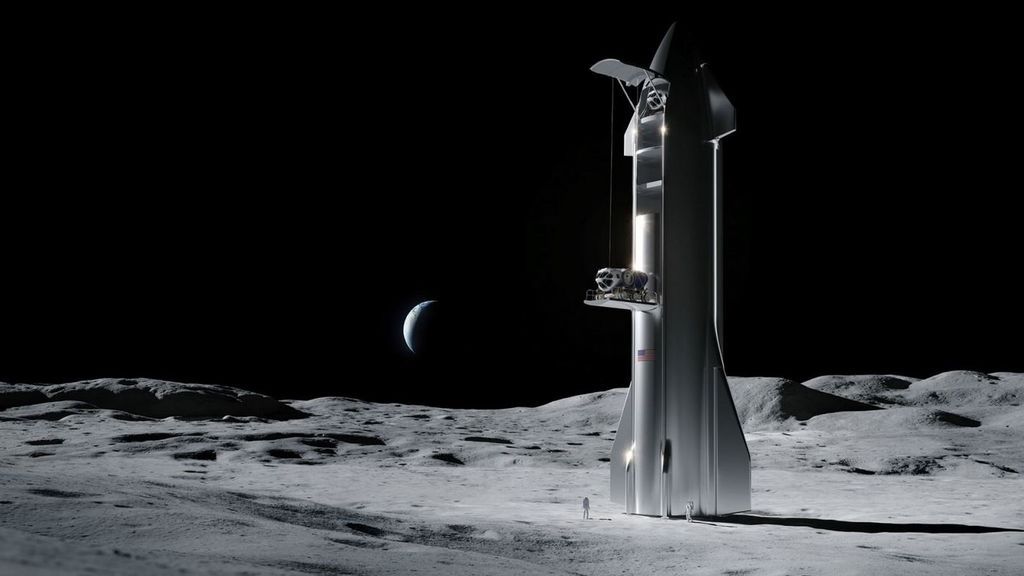-
Space X company secures a $ 2.9 billion contract to return humans to the Moon
-
According to ‘The Washington Post’, the decision is a blow to Jeff Bezos, promoter of the Blue Origin project, who was also competing for the contract
-
Bezos, one of the founders of Amazon, is also the owner of ‘The Washington Post’, which has advanced the news before the official announcement by NASA
NASA has chosen the ship with which a human being will step on the surface of the Moon again half a century after the last Apollo mission in 1972. As advanced by ‘The Washington Post’ , which cites sources of the contract that the US space agency , the only company selected from the three that were at stake, has been SpaceX . Information that NASA has confirmed in a video this afternoon.
With this decision, Elon Musk’s company wins a contract of 2,900 million dollars so that his spacecraft ‘ Starship ‘, the same one with which the tycoon wants to take human beings to Mars, is the first to take a woman already an African-American person to the Moon within NASA’s Artemis program who is scheduled to make his first manned trip to our satellite in 2024, although the new Biden administration has announced that exact timelines are under review.
The decision is considered a blow to the other two companies in the running for the contract, especially for the conglomerate of companies Blue Origin, promoted by the founder of Amazon Jeff Bezos , who had bet strongly on this project combining in his proposal giants of the aerospace industry such as Lockheed Martin, Northrop Grumman and Draper . In fact, its prototype moon lander passed a launch and landing test just two days ago.
Bezos is the owner of the newspaper ‘The Washington Post’ which has been the first to advance NASA’s decision based on documentation of the selection process. Also in the running for the contract was defense contractor Dynetics .
NASA plays it to a single card
The decision of the US space agency to choose a single company for the development of its lunar landing module contrasts with other occasions in which it has chosen to choose at least two civil contractors for this type of project. That was the case in the choice of Space X and Boing for the design of the capsule that would re-launch astronauts from US soil to the International Space Station. The justification on that occasion was that, in this way, there would be a duplication in case one of the two companies failed, as was the case. Space X’s Dragon Crew have already made two successful manned trips to the ISS , however Boing’s ship has yet to take flight.
Now NASA is betting everything on the ‘Starship’ of Space X which, according to information from ‘The Washington Post’, has been the company that has presented the lowest budget with a considerable difference compared to its competitors.
The ship that will take humanity back to the Moon is in development at the facilities of Elon Musk’s aerospace company in Texas and, for the moment, its flight tests have all ended in flames . On one occasion it managed to land successfully, but exploded shortly after landing .
The last test that ended in an explosion was the one on March 30. “At least the crater is in the right place” joked Musk on his Twitter account
At least the crater is in the right place!
— Elon Musk (@elonmusk) March 30, 2021
In addition to the budget presented by Space X, and according to information collected by ‘The Washington Post’, NASA has especially liked the ability of the Starship to carry a full crew of astronauts into space plus up to one hundred tons of cargo. According to the announcement of the space agency itself, another of the virtues of the Elon Musk prototype is its ability to be a vehicle designed as a single module, an all-in-one.
Just five days ago the founder of Space X wrote a message that now seems premonitory on his Twitter account: “We will go to the Moon very soon.”
… going to moon very soon
— Elon Musk (@elonmusk) April 10, 2021
NASA has praised the flight and landing tests of the Starship spacecraft although it has insisted that Space X must improve and achieve a reliable and safe prototype, capable of ascending and descending safely before any manned test can be authorized. That, at the moment, has not happened yet and all the tests of the ‘Starship’ have failed in the landing maneuver.
The Artemis program: to the Moon and beyond
The Artemis program was launched during the Trump administration . Among its objectives is the return to the Moon with manned missions, the construction of a space station that orbits our satellite and there to test the technologies that in the 2030s will allow to tackle the first manned trip to Mars .
The deadlines set by the previous administration were to take humans to the Moon no later than 2024. Now the calendar is under review. NASA is reviewing the SLS rocket with which it intends to take spacecraft there and the mission has received a budget for this fiscal year of 850 million dollars, far from the 3,300 million that the space agency considers necessary to meet the deadline to put a human being on the Moon in 2024.

